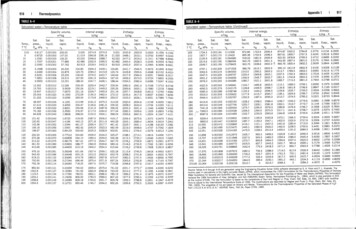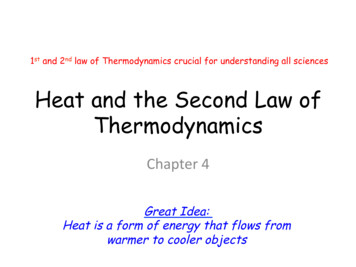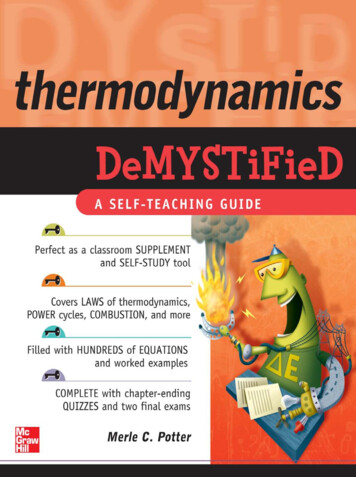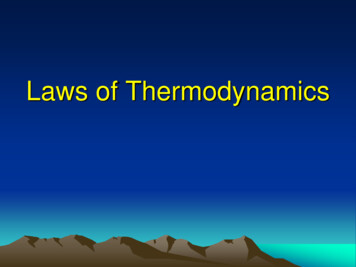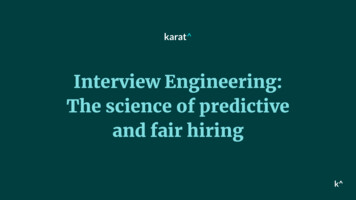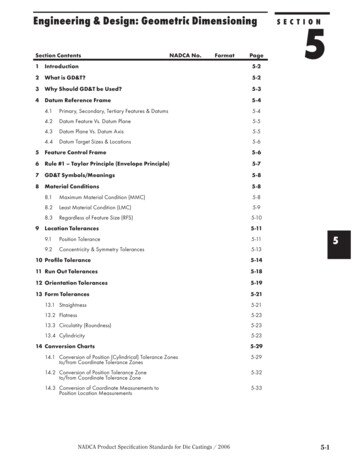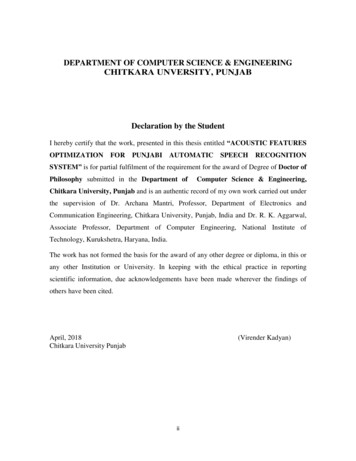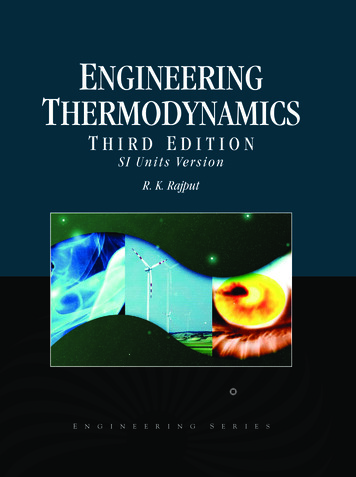
Transcription
ENGINEERINGTHERMODYNAMICSTHIRD EDITIONSI Units Ve r s io nR. K. RajputENGINEERINGSERIES
ENGINEERING THERMODYNAMICS
Also available :STEAM TABLESandMOLLIER DIAGRAM(S.I. UNITS)Edited byR.K. RAJPUTPatialaDHARMM-therm\TITLE.PM5i i
ENGINEERINGTHERMODYNAMICS[For Engineering Students of All Indian Universitiesand Competitive Examinations]S.I. UNITSByR.K. RAJPUTM.E. (Heat Power Engg.) Hons.–Gold Medallist ; Grad. (Mech. Engg. & Elect. Engg.) ;M.I.E. (India) ; M.S.E.S.I. ; M.I.S.T.E. ; C.E. (India)Principal (Formerly)Punjab College of Information TechnologyPATIALA, PunjabLAXMI PUBLICATIONS (P) LTDBANGALORE l lLUCKNOWlMUMBAIlRANCHINEW DELHIlBOSTON, USA
Published by :LAXMI PUBLICATIONS (P) LTD113, Golden House, Daryaganj,New Delhi-110002Phone : 011-43 53 25 00Fax : 011-43 53 25 com All rights reserved with the Publishers.No part of this publication may be reproduced, stored in a retrieval system, ortransmitted in any form or by any means, electronic, mechanical, photocopying,recording or otherwise without the prior written permission of the publisher.ISBN: 978-0-7637-8272-63678Price : Rs. 350.00 Only.First Edition : 1996Second Edition : 2003Third Edition : 2007Offices :India Bangalore (Phone : 080-26 61 15 61)Chennai (Phone : 044-24 34 47 26)Cochin (Phone : 0484-239 70 04)Guwahati (Phones : 0361-254 36 69, 251 38 81)Hyderabad (Phone : 040-24 75 02 47)Jalandhar (Phone : 0181-222 12 72)Kolkata (Phones : 033-22 27 37 73, 22 27 52 47)Lucknow (Phone : 0522-220 95 78)Mumbai (Phones : 022-24 91 54 15, 24 92 78 69)Ranchi (Phone : 0651-230 77 64)EET-0556-350-ENGG THERMODYNAMICSTypeset at : Goswami Printers, DelhiUSA Boston11, Leavitt Street, Hingham,MA 02043, USAPhone : 781-740-4487C—12751/06/07Printed at : Ajit Printers, Delhi
Preface to The Third EditionI am pleased to present the third edition of this book. The warm reception which theprevious editions and reprints of this book have enjoyed all over India and abroad has beena matter of great satisfaction to me.The entire book has been thoroughly revised ; a large number of solved examples (questionshaving been selected from various universities and competitive examinations) and ampleadditional text have been added.Any suggestions for the improvement of the book will be thankfully acknowledged andincorporated in the next edition.—AuthorPreface to The First EditionSeveral books are available in the market on the subject of “Engineering Thermodynamics” but either they are too bulky or are miserly written and as such do not cover thesyllabii of various Indian Universities effectively. Hence a book is needed which shouldassimilate subject matter that should primarily satisfy the requirements of the students fromsyllabus/examination point of view ; these requirements are completely met by this book.The book entails the following features :— The presentation of the subject matter is very systematic and language of the textis quite lucid and simple to understand.— A number of figures have been added in each chapter to make the subject matterself speaking to a great extent.— A large number of properly graded examples have been added in various chaptersto enable the students to attempt different types of questions in the examinationwithout any difficulty.— Highlights, objective type questions, theoretical questions, and unsolved exampleshave been added at the end of each chapter to make the book a complete unit inall respects.The author’s thanks are due to his wife Ramesh Rajput for rendering all assistanceduring preparation and proof reading of the book. The author is thankful to Mr. R.K. Syalfor drawing beautiful and well proportioned figures for the book.The author is grateful to M/s Laxmi Publications for taking lot of pains in bringing outthe book in time and pricing it moderately inspite of heavy cost of the printing.Constructive criticism is most welcome from the readers.—AuthorDHARMM-therm\TITLE.PM5v
ContentsChapterPagesIntroduction to S.I. Units and Conversion FactorsNomenclature1. INTRODUCTION—OUTLINE OF SOME DESCRIPTIVE SYSTEMS1.1.1.2.1.3.1.4.1.5.Steam Power Plant1.1.1. Layout1.1.2. Components of a modern steam power plantNuclear Power PlantInternal Combustion Engines1.3.1. Heat engines1.3.2. Development of I.C. engines1.3.3. Different parts of I.C. engines1.3.4. Spark ignition (S.I.) engines1.3.5. Compression ignition (C.I.) enginesGas Turbines1.4.1. General aspects1.4.2. Classification of gas turbines1.4.3. Merits and demerits of gas turbines1.4.4. A simple gas turbine plant1.4.5. Energy cycle for a simple-cycle gas turbineRefrigeration SystemsHighlightsTheoretical Questions2. BASIC CONCEPTS OF oduction to Kinetic Theory of GasesDefinition of ThermodynamicsThermodynamic Systems2.3.1. System, boundary and surroundings2.3.2. Closed system2.3.3. Open system2.3.4. Isolated system2.3.5. Adiabatic system2.3.6. Homogeneous system2.3.7. Heterogeneous systemMacroscopic and Microscopic Points of ViewPure SubstanceThermodynamic EquilibriumProperties of 20202121
( vii 7.2.18.2.19.2.20.PagesProcessCyclePoint FunctionPath FunctionTemperatureZeroth Law of ThermodynamicsThe Thermometer and Thermometric Property2.15.1. Introduction2.15.2. Measurement of temperature2.15.3. The international practical temperature scale2.15.4. Ideal gasPressure2.16.1. Definition of pressure2.16.2. Unit for pressure2.16.3. Types of pressure measurement devices2.16.4. Mechanical type instrumentsSpecific VolumeReversible and Irreversible ProcessesEnergy, Work and Heat2.19.1. Energy2.19.2. Work and heatReversible WorkHighlightsObjective Type QuestionsTheoretical QuestionsUnsolved Examples3. PROPERTIES OF PURE .3.11.3.12.3.13.3.14.3.15.3.16.3.17.Definition of the Pure SubstancePhase Change of a Pure Substancep-T (Pressure-temperature) Diagram for a Pure Substancep-V-T (Pressure-Volume-Temperature) SurfacePhase Change Terminology and DefinitionsProperty Diagrams in Common UseFormation of SteamImportant Terms Relating to Steam FormationThermodynamic Properties of Steam and Steam TablesExternal Work Done During EvaporationInternal Latent HeatInternal Energy of SteamEntropy of WaterEntropy of EvaporationEntropy of Wet SteamEntropy of Superheated SteamEnthalpy-Entropy (h-s) Chart or Mollier DiagramDHARMM-therm\TITLE.PM5v i 6161.63—100.6364666767686870727373737373747475
( viii )Chapter3.18.PagesDetermination of Dryness Fraction of Steam3.18.1. Tank or bucket calorimeter3.18.2. Throttling calorimeter3.18.3. Separating and throttling calorimeterHighlightsObjective Type QuestionsTheoretical QuestionsUnsolved Examples4. FIRST LAW OF 4.10.4.11.4.12.4.13.4.14.4.15.Internal EnergyLaw of Conservation of EnergyFirst Law of ThermodynamicsApplication of First Law to a ProcessEnergy—A Property of SystemPerpetual Motion Machine of the First Kind-PMM1Energy of an Isolated SystemThe Perfect Gas4.8.1. The characteristic equation of state4.8.2. Specific heats4.8.3. Joule’s law4.8.4. Relationship between two specific heats4.8.5. Enthalpy4.8.6. Ratio of specific heatsApplication of First Law of Thermodynamics to Non-flow or ClosedSystemApplication of First Law to Steady Flow ProcessEnergy Relations for Flow ProcessEngineering Applications of Steady Flow Energy Equation (S.F.E.E.)4.12.1. Water turbine4.12.2. Steam or gas turbine4.12.3. Centrifugal water pump4.12.4. Centrifugal compressor4.12.5. Reciprocating compressor4.12.6. Boiler4.12.7. Condenser4.12.8. Evaporator4.12.9. Steam nozzleThrottling Process and Joule-Thompson Porous Plug ExperimentHeating-Cooling and Expansion of VapoursUnsteady Flow ProcessesHighlightsObjective Type QuestionsTheoretical QuestionsUnsolved 9. 0215216219219
( ix )ChapterPages5. SECOND LAW OF THERMODYNAMICS AND ions of First Law of Thermodynamics and Introduction toSecond LawPerformance of Heat Engines and Reversed Heat EnginesReversible ProcessesStatements of Second Law of Thermodynamics5.4.1. Clausius statement5.4.2. Kelvin-Planck statement5.4.3. Equivalence of Clausius statement to the Kelvin-PlanckstatementPerpetual Motion Machine of the Second KindThermodynamic TemperatureClausius InequalityCarnot CycleCarnot’s TheoremCorollary of Carnot’s TheoremEfficiency of the Reversible Heat EngineEntropy5.12.1. Introduction5.12.2. Entropy—a property of a system5.12.3. Change of entropy in a reversible processEntropy and IrreversibilityChange in Entropy of the UniverseTemperature Entropy DiagramCharacteristics of EntropyEntropy Changes for a Closed System5.17.1. General case for change of entropy of a gas5.17.2. Heating a gas at constant volume5.17.3. Heating a gas at constant pressure5.17.4. Isothermal process5.17.5. Adiabatic process (reversible)5.17.6. Polytropic process5.17.7. Approximation for heat absorbedEntropy Changes for an Open SystemThe Third Law of ThermodynamicsHighlightsObjective Type QuestionsTheoretical QuestionsUnsolved Examples6. AVAILABILITY AND IRREVERSIBILITY6.1.6.2.6.3.6.4.Available and Unavailable EnergyAvailable Energy Referred to a CycleDecrease in Available Energy When Heat is Transferred Througha Finite Temperature DifferenceAvailability in Non-flow SystemsDHARMM-therm\TITLE.PM5i x. 3264265298299302302. 306—340.306306.308310
(x)Chapter6.5.6.6.6.7.6.8.PagesAvailability in Steady-flow SystemsHelmholtz and Gibb’s ective Type QuestionsTheoretical QuestionsUnsolved Examples7. THERMODYNAMIC RELATIONS7.1.7.2.7.3.7.4.7.5.7.6.7.7.General AspectsFundamentals of Partial DifferentiationSome General Thermodynamic RelationsEntropy Equations (Tds Equations)Equations for Internal Energy and EnthalpyMeasurable Quantities7.6.1. Equation of state7.6.2. Co-efficient of expansion and compressibility7.6.3. Specific heats7.6.4. Joule-Thomson co-efficientClausius-Claperyon EquationHighlightsObjective Type QuestionsExercises8. IDEAL AND REAL .8.12.IntroductionThe Equation of State for a Perfect Gasp-V-T Surface of an Ideal GasInternal Energy and Enthalpy of a Perfect GasSpecific Heat Capacities of an Ideal GasReal GasesVan der Waal’s EquationVirial Equation of StateBeattie-Bridgeman EquationReduced PropertiesLaw of Corresponding StatesCompressibility ChartHighlightsObjective Type QuestionsTheoretical QuestionsUnsolved Examples9. GASES AND VAPOUR MIXTURES9.1.Introductionx311311312313336337338338. 75. 08408409. 411—448.DHARMM-therm\TITLE.PM5.411
( xi )Chapter9.2.9.3.9.4.9.5.9.6.9.7.PagesDalton’s Law and Gibbs-Dalton LawVolumetric Analysis of a Gas MixtureThe Apparent Molecular Weight and Gas ConstantSpecific Heats of a Gas MixtureAdiabatic Mixing of Perfect GasesGas and Vapour MixturesHighlightsObjective Type QuestionsTheoretical QuestionsUnsolved Examples10. t of Psychrometry and PsychrometricsDefinitionsPsychrometric RelationsPsychrometersPsychrometric ChartsPsychrometric Processes10.6.1. Mixing of air streams10.6.2. Sensible heating10.6.3. Sensible cooling10.6.4. Cooling and dehumidification10.6.5. Cooling and humidification10.6.6. Heating and dehumidification10.6.7. Heating and humidificationHighlightsObjective Type QuestionsTheoretical QuestionsUnsolved Examples11. CHEMICAL ductionClassification of FuelsSolid FuelsLiquid FuelsGaseous FuelsBasic ChemistryCombustion EquationsTheoretical Air and Excess AirStoichiometric Air Fuel (A/F) RatioAir-Fuel Ratio from Analysis of ProductsHow to Convert Volumetric Analysis to Weight AnalysisHow to Convert Weight Analysis to Volumetric AnalysisWeight of Carbon in Flue GasesWeight of Flue Gases per kg of Fuel BurntAnalysis of Exhaust and Flue GasDHARMM-therm\TITLE.PM5x i.411413414417418419444444445445. 83483484485. 95495
( xii )ChapterPages11.16.11.17.11.18.11.19.Internal Energy and Enthalpy of ReactionEnthalpy of Formation ( Hf)Calorific or Heating Values of FuelsDetermination of Calorific or Heating Values11.19.1. Solid and Liquid Fuels11.19.2. Gaseous Fuels11.20. Adiabatic Flame Temperature11.21. Chemical Equilibrium11.22. Actual Combustion AnalysisHighlightsObjective Type QuestionsTheoretical QuestionsUnsolved Examples12. VAPOUR POWER CYCLES12.1.12.2.12.3.12.4.12.5.12.6.Carnot CycleRankine CycleModified Rankine CycleRegenerative CycleReheat CycleBinary Vapour CycleHighlightsObjective Type QuestionsTheoretical QuestionsUnsolved Examples13. GAS POWER n of a CycleAir Standard EfficiencyThe Carnot CycleConstant Volume or Otto CycleConstant Pressure or Diesel CycleDual Combustion CycleComparison of Otto, Diesel and Dual Combustion Cycles13.7.1. Efficiency versus compression ratio13.7.2. For the same compression ratio and the same heat input13.7.3. For constant maximum pressure and heat supplied13.8. Atkinson Cycle13.9. Ericsson Cycle13.10. Gas Turbine Cycle-Brayton Cycle13.10.1. Ideal Brayton cycle13.10.2. Pressure ratio for maximum work13.10.3. Work ratio13.10.4. Open cycle gas turbine-actual brayton cycle13.10.5. Methods for improvement of thermal efficiency of open cyclegas turbine plantDHARMM-therm\TITLE.PM5x i i.497500501501502504506506507537538539540. 543—603.543544557562576584601601602603. 61663664665.667
( xiii )ChapterPages13.10.6. Effect of operating variables on thermal efficiency13.10.7. Closed cycle gas turbine13.10.8. Gas turbine fuelsHighlightsTheoretical QuestionsObjective Type QuestionsUnsolved Examples14. REFRIGERATION CYCLES14.1.14.2.14.3.14.4.14.5. 713—777Fundamentals of Refrigeration.14.1.1. Introduction.14.1.2. Elements of refrigeration systems.14.1.3. Refrigeration systems.14.1.4. Co-efficient of performance (C.O.P.).14.1.5. Standard rating of a refrigeration machine.Air Refrigeration System.14.2.1. Introduction.14.2.2. Reversed Carnot cycle.14.2.3. Reversed Brayton cycle.14.2.4. Merits and demerits of air refrigeration system.Simple Vapour Compression System.14.3.1. Introduction.14.3.2. Simple vapour compression cycle.14.3.3. Functions of parts of a simple vapour compression system.14.3.4. Vapour compression cycle on temperature-entropy (T-s) diagram .14.3.5. Pressure-enthalpy (p-h) chart.14.3.6. Simple vapour compression cycle on p-h chart.14.3.7. Factors affecting the performance of a vapour compressionsystem.14.3.8. Actual vapour compression cycle.14.3.9. Volumetric efficiency.14.3.10. Mathematical analysis of vapour compression refrigeration.Vapour Absorption System.14.4.1. Introduction.14.4.2. Simple vapour absorption system.14.4.3. Practical vapour absorption system.14.4.4. Comparison between vapour compression and vapourabsorption systems.Refrigerants.14.5.1. Classification of refrigerants.14.5.2. Desirable properties of an ideal refrigerant.14.5.3. Properties and uses of commonly used refrigerants.Highlights.Objective Type Questions.Theoretical Questions.Unsolved 71772773774
( xiv )ChapterPages15. HEAT TRANSFER15.1.15.2.15.3.15.4.15.5.Modes of Heat TransferHeat Transmission by Conduction15.2.1. Fourier’s law of conduction15.2.2. Thermal conductivity of materials15.2.3. Thermal resistance (Rth)15.2.4. General heat conduction equation in cartesian coordinates15.2.5. Heat conduction through plane and composite walls15.2.6. The overall heat transfer coefficient15.2.7. Heat conduction through hollow and composite cylinders15.2.8. Heat conduction through hollow and composite spheres15.2.9. Critical thickness of insulationHeat Transfer by ConvectionHeat Exchangers15.4.1. Introduction15.4.2. Types of heat exchangers15.4.3. Heat exchanger analysis15.4.4. Logarithmic temperature difference (LMTD)Heat Transfer by Radiation15.5.1. Introduction15.5.2. Surface emission properties15.5.3. Absorptivity, reflectivity and transmittivity15.5.4. Concept of a black body15.5.5. The Stefan-Boltzmann law15.5.6. Kirchhoff ’s law15.5.7. Planck’s law15.5.8. Wien’s displacement law15.5.9. Intensity of radiation and Lambert’s cosine law15.5.10. Radiation exchange between black bodies separated by anon-absorbing mediumHighlightsObjective Type QuestionsTheoretical QuestionsUnsolved Examples16. COMPRESSIBLE FLOW16.1.16.2.16.3.IntroductionBasic Equations of Compressible Fluid Flow16.2.1. Continuity equation16.2.2. Momentum equation16.2.3. Bernoulli’s or energy equationPropagation of Disturbances in Fluid and Velocity of Sound16.3.1. Derivation of sonic velocity (velocity of sound)16.3.2. Sonic velocity in terms of bulk modulus16.3.3. Sonic velocity for isothermal process16.3.4. Sonic velocity for adiabatic processDHARMM-therm\TITLE.PM5x i v. 2854854. 857—903.857857857858858862862864864865
( xv )ChapterPages16.4.16.5.16.6.Mach NumberPropagation of Disturbance in Compressible FluidStagnation Properties16.6.1. Expression for stagnation pressure (ps) in compressible flow16.6.2. Expression for stagnation density (ρs)16.6.3. Expression for stagnation temperature (Ts)16.7. Area—Velocity Relationship and Effect of Variation of Area forSubsonic, Sonic and Supersonic Flows16.8. Flow of Compressible Fluid Through a Convergent Nozzle16.9. Variables of Flow in Terms of Mach Number16.10. Flow Through Laval Nozzle (Convergent-divergent Nozzle)16.11. Shock Waves16.11.1. Normal shock wave16.11.2. Oblique shock wave16.11.3. Shock StrengthHighlightsObjective Type QuestionsTheoretical QuestionsUnsolved 5895896899901902Competitive Examinations Questions with Answers.904—919Index.920—922Steam Tables and Mollier Diagram.(i)—(xx)DHARMM-therm\TITLE.PM5x v
Introduction to SI Units and Conversion FactorsA. INTRODUCTION TO SI
tromagnetic, thermal, and stress design simulation with coupled multi-fi eld analysis. Also includes tutorials. . Intended as an introductory textbook for “applied” or engineering thermodynamics, or for use . Several books are available in the marke
